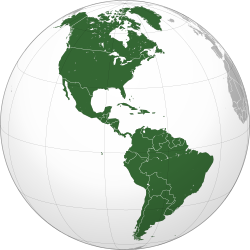Western Hemisphere
Geopolitical

The Western Hemisphere is a geopolitical term term for "the hemisphere of the world containing the Americas." [1] The Western Hemisphere consists of the Americas, adjacent islands, and surrounding waters. Longitude 160° E to longitude 20° W are considered the boundaries of the geopolitical Western Hemisphere.[1][2][3]
Geographical

The geographical western hemisphere is the half of the Earth that lies west of the Prime Meridian, which goes through Greenwich, London, United Kingdom, and east of the Antimeridian, the other half being called the Eastern Hemisphere.[4][5][6]
Before the International Meridian Conference settled on the Greenwich Meridian[7] as the international prime meridian, cartographers and navigators used dozens of different longitudes for their prime meridians. Only after the October 1884[7] agreement did the geographical definition given here become universal.
In this sense, the Western Hemisphere consists of the Americas, the western portions of Europe and Africa, the extreme eastern tip of Russia, numerous territories in Oceania, and a portion of Antarctica, while excluding some of the Aleutian Islands to the southwest of the Alaskan mainland.[3]
This meaning of western hemisphere is used in the fields of navigation, geography, and cartography[8]
Sources
- ^ a b
"Western Hemisphere", Merriam-Webster's Geographical Dictionary (3rd ed.), Springfield, MA: Merriam-Webster, 2001, p. 1294,
The part of the Earth comprising North and South America and surrounding waters; longitudes 20°W and 160°E are often considered its boundaries
.
"Encyclopedia Britannica". Retrieved 20 May 2015.Western Hemisphere, Part of Earth comprising North and South America and the surrounding waters. Longitudes 20° W and 160° E are often considered its boundaries.
O'Neal, Mary, ed. (2011). The Chambers Dictionary (12 ed.). London: Chambers Harrap Publishers, Ltd. p. 1780. ISBN 978-0550-10237-9.This dictionary was written with the British speaker of English in mind. ... The Western Hemisphere is the half of the world that includes North America and South America
The World Book Dictionary. Chicago: World Book, Inc. 2003. p. 2377. ISBN 0-7166-0299-7.Western Hemisphere, the half of the world that includes North and South America.
The American Heritage College Dictionary (Fourth ed.). Boston: Houghton Mifflin Harcourt. 2010. p. 1557. ISBN 978-0618835959.Western Hemisphere The half of the earth comprising North America, Central America, and South America
Stevenson, Angus; Lindberg, Christine A., eds. (2010). New Oxford American Dictionary (Third ed.). New York: Oxford University Press. p. 1963.The Half of the earth that contains the Americas
Webster's New World College Dictionary (Fifth ed.). Boston: Houghton Mifflin Harcourt. 2014. ISBN 978-0-544-16606-6.Western Hemisphere that half of the earth which includes North & South America
United States Department of State, Bureau of Western Hemisphere Affairs, at http://www.state.gov/p/wha/index.htm - ^ "Encyclopedia Britannica". Retrieved 20 May 2015.
Western Hemisphere, Part of Earth comprising North and South America and the surrounding waters. Longitudes 20° W and 160° E are often considered its boundaries.
- ^ a b Olson, Judy M (1997), "Projecting the hemisphere", in Robinson, Arthur H; Snyder, John P (eds.), Matching the map projection to the need, Bethesda, MD: Cartography and Geographic Information Society, American Congress on Surveying and Mapping
{{citation}}: External link in|title= - ^ Britannica
- ^ Oxford Dictionary of English (2nd ed.), London, UK: Oxford University Press, 2006, p. 2001
- ^ "Western Hemisphere", Merriam Webster's Online Dictionary (based on Collegiate vol., 11th ed.), Springfield, MA: Merriam-Webster, 2006
- ^ a b "International Conference Held at Washington for the Purpose of Fixing a Prime Meridian and a Universal Day. October, 1884. Protocols of the proceedings". Project Gutenberg. 1884. Retrieved 30 November 2012.
- ^ "III. Today's Realities". UNITED STATES COAST GUARD WESTERN HEMISPHERE STRATEGY (PDF) (CG-DCO-X ed.). Washington, D.C.: Government Printing Office. September 2014. p. 13.
For the purpose of this strategy and associated implementation plans, the Western Hemisphere is defined as the geographic region spanning the area between the International Date Line and the Prime Meridian. It does not include the Polar Regions in either the Northern or Southern Hemispheres, and maintains a decided focus on our strategic priorities in the Americas.
External links
![]() Media related to Western Hemisphere at Wikimedia Commons
0°N 90°W / 0°N 90°W
Media related to Western Hemisphere at Wikimedia Commons
0°N 90°W / 0°N 90°W
